Chengcheng Tang
HuMoCon: Concept Discovery for Human Motion Understanding
May 27, 2025
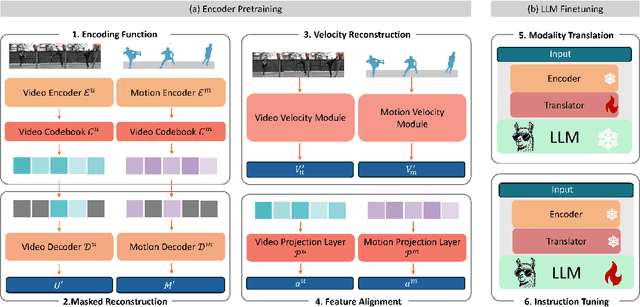
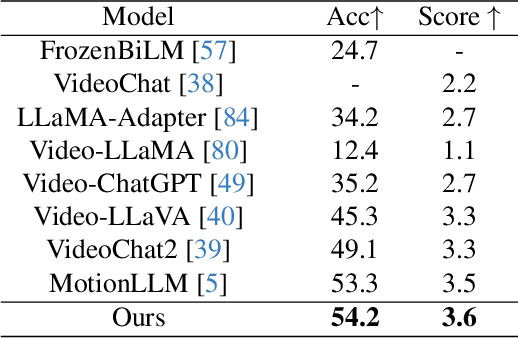

Abstract:We present HuMoCon, a novel motion-video understanding framework designed for advanced human behavior analysis. The core of our method is a human motion concept discovery framework that efficiently trains multi-modal encoders to extract semantically meaningful and generalizable features. HuMoCon addresses key challenges in motion concept discovery for understanding and reasoning, including the lack of explicit multi-modality feature alignment and the loss of high-frequency information in masked autoencoding frameworks. Our approach integrates a feature alignment strategy that leverages video for contextual understanding and motion for fine-grained interaction modeling, further with a velocity reconstruction mechanism to enhance high-frequency feature expression and mitigate temporal over-smoothing. Comprehensive experiments on standard benchmarks demonstrate that HuMoCon enables effective motion concept discovery and significantly outperforms state-of-the-art methods in training large models for human motion understanding. We will open-source the associated code with our paper.
* 18 pages, 10 figures
CigTime: Corrective Instruction Generation Through Inverse Motion Editing
Dec 06, 2024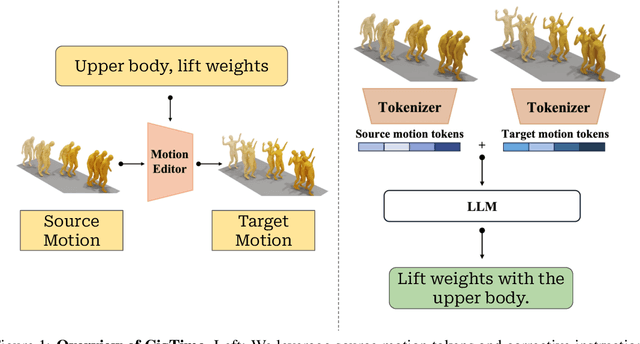

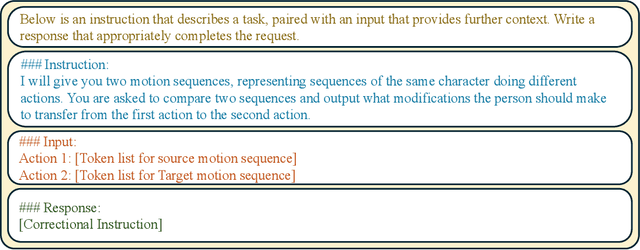

Abstract:Recent advancements in models linking natural language with human motions have shown significant promise in motion generation and editing based on instructional text. Motivated by applications in sports coaching and motor skill learning, we investigate the inverse problem: generating corrective instructional text, leveraging motion editing and generation models. We introduce a novel approach that, given a user's current motion (source) and the desired motion (target), generates text instructions to guide the user towards achieving the target motion. We leverage large language models to generate corrective texts and utilize existing motion generation and editing frameworks to compile datasets of triplets (source motion, target motion, and corrective text). Using this data, we propose a new motion-language model for generating corrective instructions. We present both qualitative and quantitative results across a diverse range of applications that largely improve upon baselines. Our approach demonstrates its effectiveness in instructional scenarios, offering text-based guidance to correct and enhance user performance.
BID: Boundary-Interior Decoding for Unsupervised Temporal Action Localization Pre-Trainin
Mar 12, 2024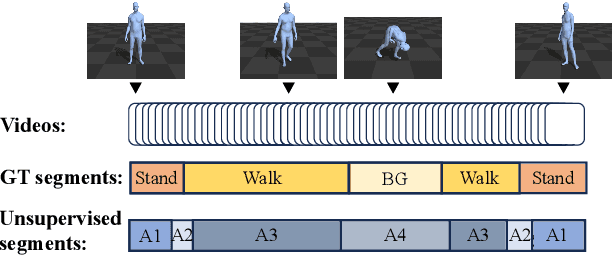
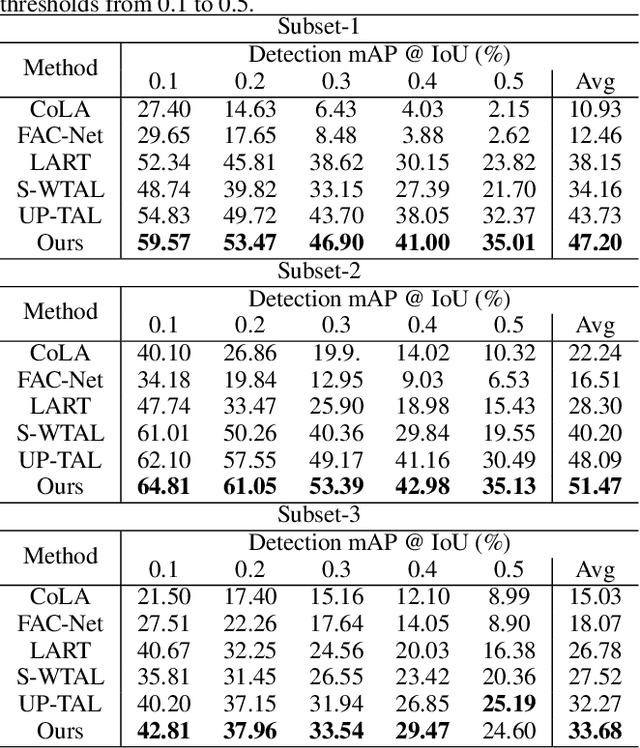
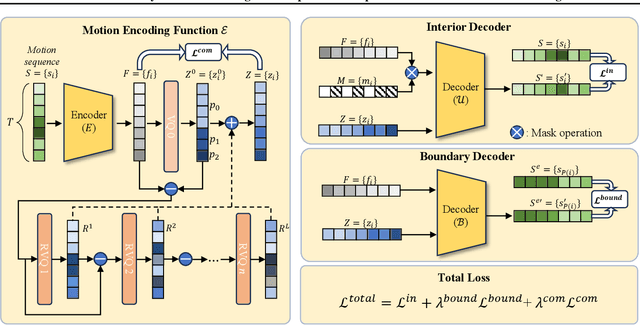

Abstract:Skeleton-based motion representations are robust for action localization and understanding for their invariance to perspective, lighting, and occlusion, compared with images. Yet, they are often ambiguous and incomplete when taken out of context, even for human annotators. As infants discern gestures before associating them with words, actions can be conceptualized before being grounded with labels. Therefore, we propose the first unsupervised pre-training framework, Boundary-Interior Decoding (BID), that partitions a skeleton-based motion sequence into discovered semantically meaningful pre-action segments. By fine-tuning our pre-training network with a small number of annotated data, we show results out-performing SOTA methods by a large margin.
EMDB: The Electromagnetic Database of Global 3D Human Pose and Shape in the Wild
Aug 31, 2023


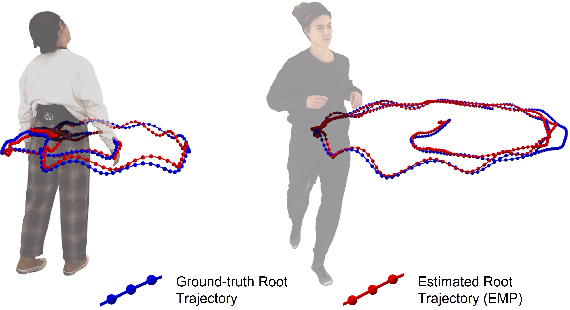
Abstract:We present EMDB, the Electromagnetic Database of Global 3D Human Pose and Shape in the Wild. EMDB is a novel dataset that contains high-quality 3D SMPL pose and shape parameters with global body and camera trajectories for in-the-wild videos. We use body-worn, wireless electromagnetic (EM) sensors and a hand-held iPhone to record a total of 58 minutes of motion data, distributed over 81 indoor and outdoor sequences and 10 participants. Together with accurate body poses and shapes, we also provide global camera poses and body root trajectories. To construct EMDB, we propose a multi-stage optimization procedure, which first fits SMPL to the 6-DoF EM measurements and then refines the poses via image observations. To achieve high-quality results, we leverage a neural implicit avatar model to reconstruct detailed human surface geometry and appearance, which allows for improved alignment and smoothness via a dense pixel-level objective. Our evaluations, conducted with a multi-view volumetric capture system, indicate that EMDB has an expected accuracy of 2.3 cm positional and 10.6 degrees angular error, surpassing the accuracy of previous in-the-wild datasets. We evaluate existing state-of-the-art monocular RGB methods for camera-relative and global pose estimation on EMDB. EMDB is publicly available under https://ait.ethz.ch/emdb
Visual Estimation of Fingertip Pressure on Diverse Surfaces using Easily Captured Data
Jan 05, 2023



Abstract:Prior research has shown that deep models can estimate the pressure applied by a hand to a surface based on a single RGB image. Training these models requires high-resolution pressure measurements that are difficult to obtain with physical sensors. Additionally, even experts cannot reliably annotate pressure from images. Thus, data collection is a critical barrier to generalization and improved performance. We present a novel approach that enables training data to be efficiently captured from unmodified surfaces with only an RGB camera and a cooperative participant. Our key insight is that people can be prompted to perform actions that correspond with categorical labels (contact labels) describing contact pressure, such as using a specific fingertip to make low-force contact. We present ContactLabelNet, which visually estimates pressure applied by fingertips. With the use of contact labels, ContactLabelNet achieves improved performance, generalizes to novel surfaces, and outperforms models from prior work.
MotionDeltaCNN: Sparse CNN Inference of Frame Differences in Moving Camera Videos
Oct 18, 2022



Abstract:Convolutional neural network inference on video input is computationally expensive and has high memory bandwidth requirements. Recently, researchers managed to reduce the cost of processing upcoming frames by only processing pixels that changed significantly. Using sparse convolutions, the sparsity of frame differences can be translated to speedups on current inference devices. However, previous work was relying on static cameras. Moving cameras add new challenges in how to fuse newly unveiled image regions with already processed regions efficiently to minimize the update rate - without increasing memory overhead and without knowing the camera extrinsics of future frames. In this work, we propose MotionDeltaCNN, a CNN framework that supports moving cameras and variable resolution input. We propose a spherical buffer which enables seamless fusion of newly unveiled regions and previously processed regions - without increasing the memory footprint. Our evaluations show that we outperform previous work significantly by explicitly adding support for moving camera input.
Visual Pressure Estimation and Control for Soft Robotic Grippers
Apr 14, 2022



Abstract:Soft robotic grippers facilitate contact-rich manipulation, including robust grasping of varied objects. Yet the beneficial compliance of a soft gripper also results in significant deformation that can make precision manipulation challenging. We present visual pressure estimation & control (VPEC), a method that uses a single RGB image of an unmodified soft gripper from an external camera to directly infer pressure applied to the world by the gripper. We present inference results for a pneumatic gripper and a tendon-actuated gripper making contact with a flat surface. We also show that VPEC enables precision manipulation via closed-loop control of inferred pressure. We present results for a mobile manipulator (Stretch RE1 from Hello Robot) using visual servoing to do the following: achieve target pressures when making contact; follow a spatial pressure trajectory; and grasp small objects, including a microSD card, a washer, a penny, and a pill. Overall, our results show that VPEC enables grippers with high compliance to perform precision manipulation.
PressureVision: Estimating Hand Pressure from a Single RGB Image
Mar 19, 2022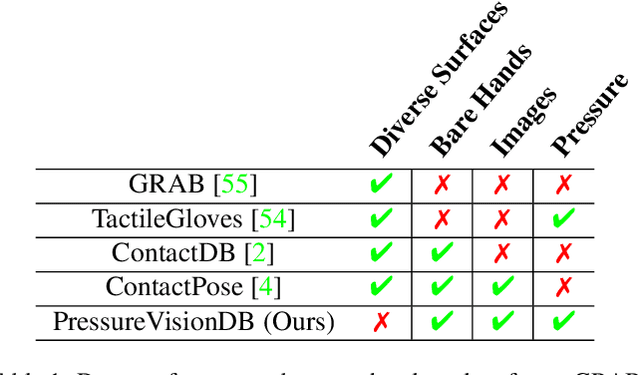



Abstract:People often interact with their surroundings by applying pressure with their hands. Machine perception of hand pressure has been limited by the challenges of placing sensors between the hand and the contact surface. We explore the possibility of using a conventional RGB camera to infer hand pressure. The central insight is that the application of pressure by a hand results in informative appearance changes. Hands share biomechanical properties that result in similar observable phenomena, such as soft-tissue deformation, blood distribution, hand pose, and cast shadows. We collected videos of 36 participants with diverse skin tone applying pressure to an instrumented planar surface. We then trained a deep model (PressureVisionNet) to infer a pressure image from a single RGB image. Our model infers pressure for participants outside of the training data and outperforms baselines. We also show that the output of our model depends on the appearance of the hand and cast shadows near contact regions. Overall, our results suggest the appearance of a previously unobserved human hand can be used to accurately infer applied pressure.
DeltaCNN: End-to-End CNN Inference of Sparse Frame Differences in Videos
Mar 08, 2022



Abstract:Convolutional neural network inference on video data requires powerful hardware for real-time processing. Given the inherent coherence across consecutive frames, large parts of a video typically change little. By skipping identical image regions and truncating insignificant pixel updates, computational redundancy can in theory be reduced significantly. However, these theoretical savings have been difficult to translate into practice, as sparse updates hamper computational consistency and memory access coherence; which are key for efficiency on real hardware. With DeltaCNN, we present a sparse convolutional neural network framework that enables sparse frame-by-frame updates to accelerate video inference in practice. We provide sparse implementations for all typical CNN layers and propagate sparse feature updates end-to-end - without accumulating errors over time. DeltaCNN is applicable to all convolutional neural networks without retraining. To the best of our knowledge, we are the first to significantly outperform the dense reference, cuDNN, in practical settings, achieving speedups of up to 7x with only marginal differences in accuracy.
ContactOpt: Optimizing Contact to Improve Grasps
Apr 15, 2021
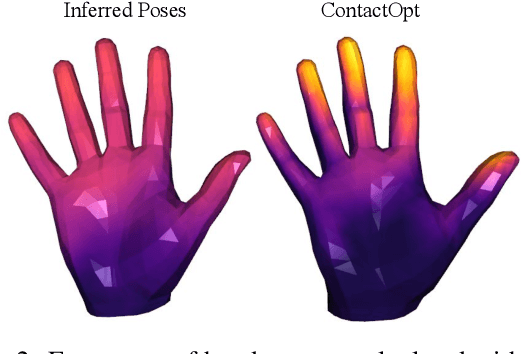


Abstract:Physical contact between hands and objects plays a critical role in human grasps. We show that optimizing the pose of a hand to achieve expected contact with an object can improve hand poses inferred via image-based methods. Given a hand mesh and an object mesh, a deep model trained on ground truth contact data infers desirable contact across the surfaces of the meshes. Then, ContactOpt efficiently optimizes the pose of the hand to achieve desirable contact using a differentiable contact model. Notably, our contact model encourages mesh interpenetration to approximate deformable soft tissue in the hand. In our evaluations, our methods result in grasps that better match ground truth contact, have lower kinematic error, and are significantly preferred by human participants. Code and models are available online.
 Add to Chrome
Add to Chrome Add to Firefox
Add to Firefox Add to Edge
Add to Edge